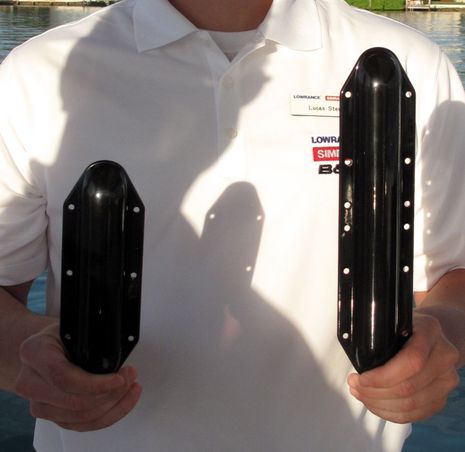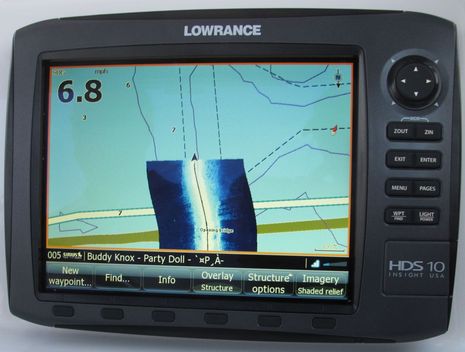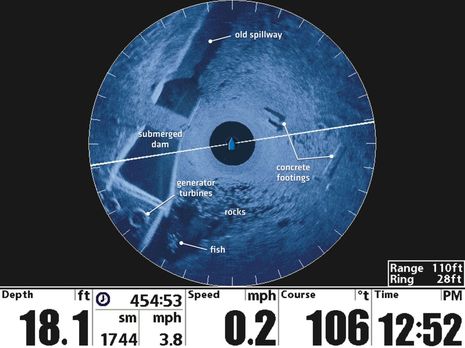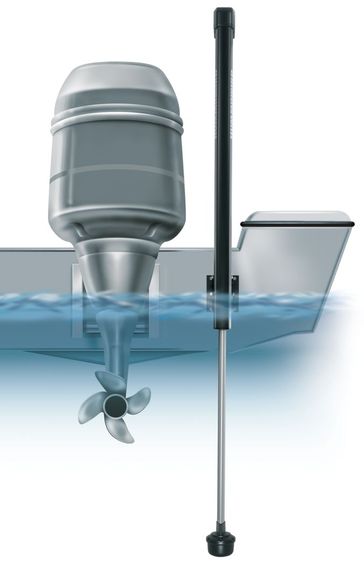Sonar wars: Navico StructureScan HD & Humminbird 360

Yes, there was some jocularity in Miami about the manliness of the new Lowrance StructureScan HD transducer, once it was whipped out by Lucas Steward (of tricked-out Hobie Pro Angler fame). But more impressive than what an SS HD user gets to show off at the launching ramp is what they'll see on screen. Navico has managed to give StructureScan more range and improved resolution while also simplifying its use and keeping the price the same (at about $600 for the new transom transducer and LSS-2 module)...
What makes the second generation StructureScan easier to use is that it only runs on one frequency, 455 kHz, instead of two. That's because Navico sonar engineers were able to narrow the 455 beam width with that longer transducer and thus the higher 800kHz resolution of the original model was no longer needed. I frequently change frequencies on the original as depth varies, trading detail for range and vice-versa, and I wouldn't miss those trade offs at all!
Having used StructureScan myself for two seasons (last major entry here), I can report without reservation that HD is better. When we weren't being chased off by harbor police, we scanned a variety of depths and structure around Miami Harbor and HD's ability to reach out further to the sides, and down look with greater detail, were obvious. HD also worked nicely with the StructureMap option that was discussed here along with Lowrance HDS Gen2 displays in December. Plus I've learned that boaters without Gen2 can generate StructureMap style overlays, and even view them on an iPad, using DrDepth software tools (which I intend to try with some of the SS files I saved last summer). And I have no doubt that StructureScan HD and StructureMap will be coming to Simrad systems eventually. All good!

While Humminbird -- whose Side Imaging was once a match for StructureScan, I thought -- has yet to counter HD, the company caused a stir with the announcement of 360 Imaging. The technology surprised me too. For years I've been trying to explain to people that the narrow beam sonar used in Side Imaging and StructureScan couldn't look ahead because it can only build up a usable image from side slices. But it didn't occur to me that you could take a similar transducer and spin it at the bottom of a transom-mounted pole! Say hello to Humminbird 360 Imaging, due out in August for about $2,000...

So 360 Imaging is vaguely like commercial side scan sonars, except with the structure detailing (and short range) of high frequency and ultra narrow beam. You can just sit still and look all around or you can command the transducer to limit scanning to a sector ahead as you motor along slowly. But while it may be great for the freshwater fishing market that's core to these technologies, the transducer rig below would be hard to adapt to a saltwater cruising boat, and I'm not sure it would last. StrutureScan HD, however, will be even better for gunkholers like me than the original and let's not forget that Garmin recently acquired Forward Looking Sonar pioneer Interphase. I'm really looking forward to what that combination will yield, and if I were working at one of the other Big Four, I'd sure be thinking about an FLS competitive stradegy. All good!


 Share
Share
Some interesting LSS-1 versus LSS-2 testing on the HullTruth, but I too wonder if it's a fair comparison in terms of the terms of the different model's software development: http://goo.gl/LV2tq